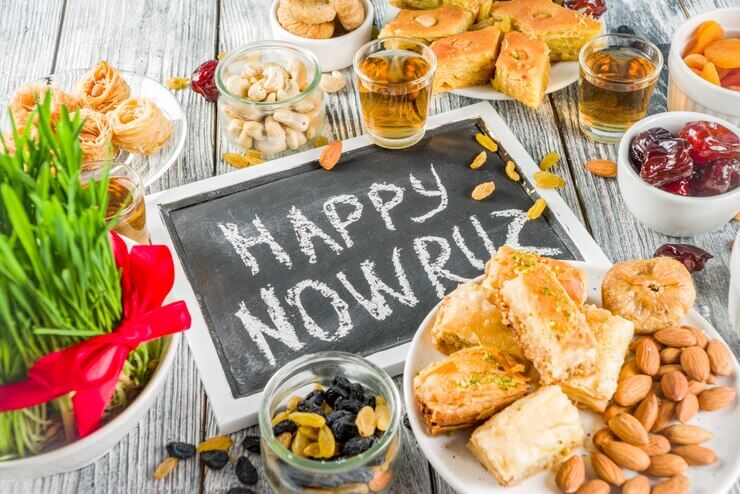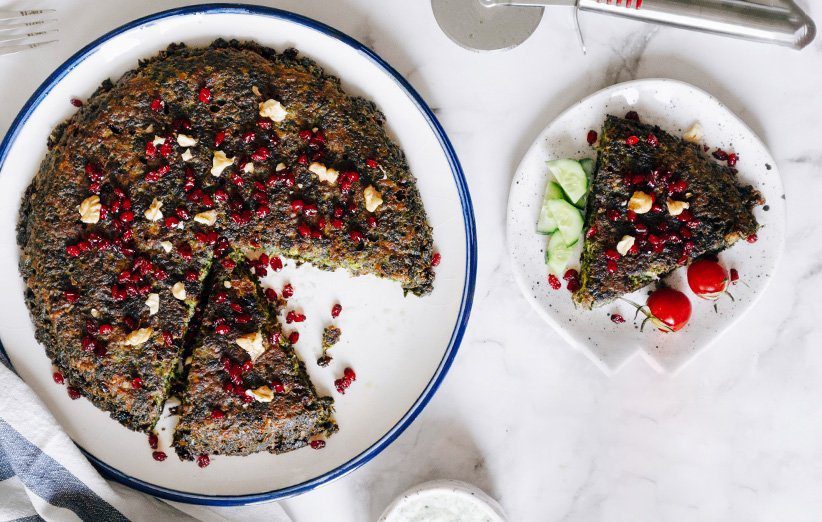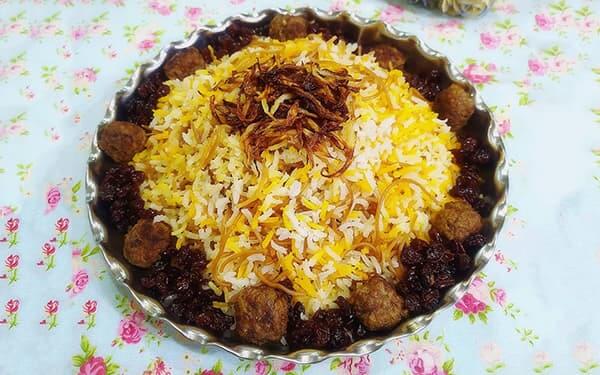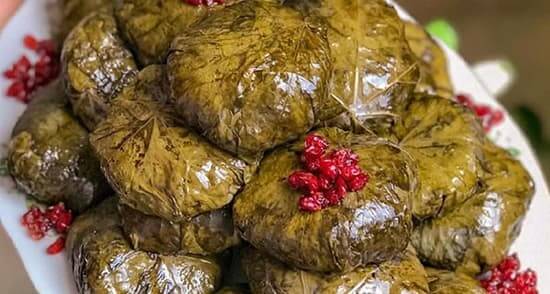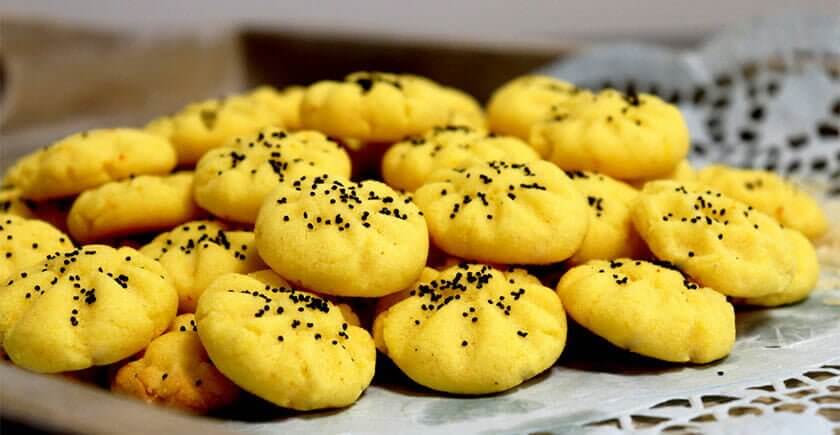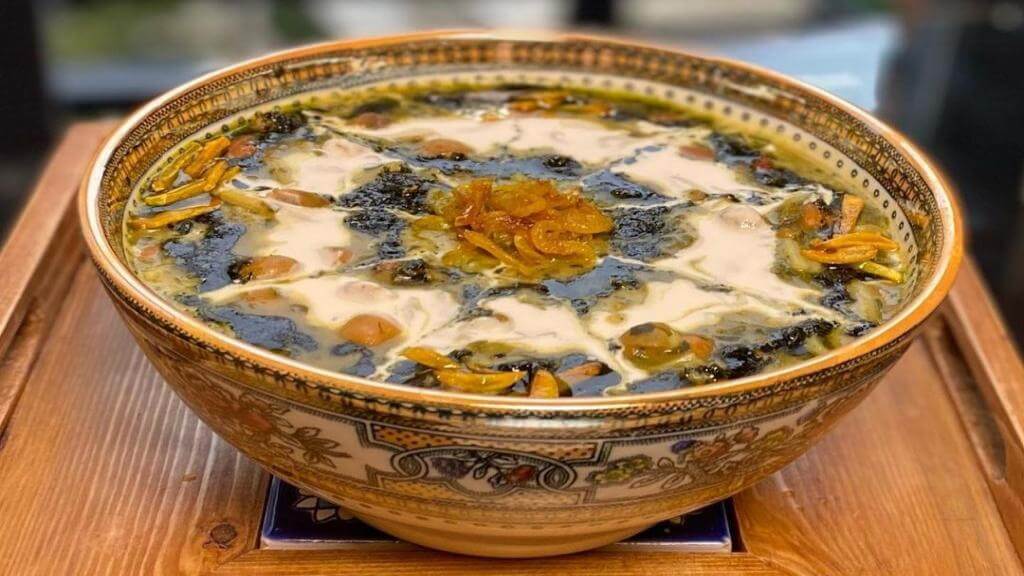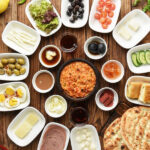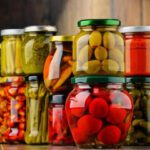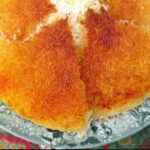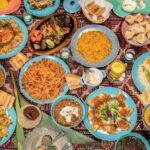Have you ever heard anything about Nowruz? Do you know what exactly it is? If not, I will tell you completely! Iranians celebrate the arrival of spring and Persian new year with a ceremony called “Nowruz.” Nowruz or sometimes pronounce Norooz or Norous is based on astronomical celestial events and dates from the Zoroastrian era back to more than 3000 years ago. It means that there is no sign of religion in it.
This ceremony is not just limited to Iran, and it is celebrated by many people throughout central Asia such as Afghanistan, Azerbaijan, and Uzbekistan. It takes a 13-day holiday in Iran, and people visit all of their relatives during this time. Besides all of Nowruz cultures, Nowruz foods are an inseparable part of this ancient celebration. You do not have to miss cooking Nowruz foods, especially on the 20th of March, when the Persian new year starts. There are numerous dishes of Persian new year foods that you cannot resist. They create one of your unforgettable memories of all time! It would be so exciting to take a look at these hearty and mouthwatering foods. So let’s get to know what we can find at the Nowruz table. I am sure you would love all of them.
Persian new year Haft Sin
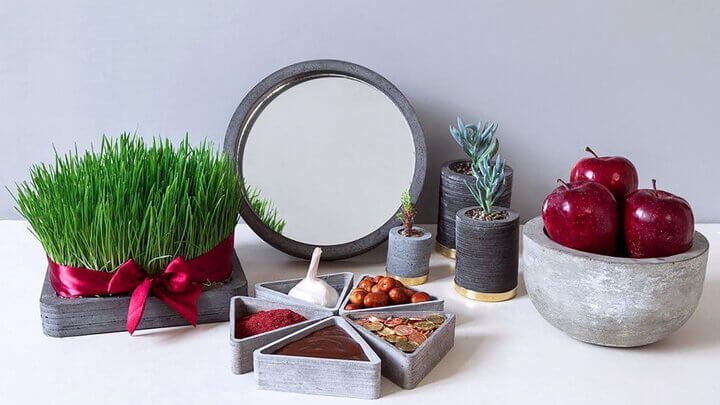
The centrepiece of Nowruz table is definitely the Haft Sin or Haft Seen. It is a table containing 7 Symbolic items which start with the letter “S.” Each of them represents a specific concept and gives hope, energy, and freshness to people in order to start a new year and a new life. All of these items are foodstuff. Although they are not going to be eaten, they participate in the ceremony until the 13th day of the holidays! What does haft sin include?
- Sabzeh: Planting Sabzeh is an old tradition among Iranians. People plant small pots of wheat, barley, or lentils that quickly germinate into lush green sprouts called “Sabzeh.” It represents rebirth, rejuvenation, prosperity, and growth.
- Seer: Seer is garlic in Persian and symbolizes medicine and health. It reminds people to take good care of themselves in the new year.
- Serkeh: Serkeh or vinegar is a great sign of wisdom and age. It takes a long time to prepare vinegar, and this shows the importance of growing older, maturing, patience, and developing in our lives.
- Sumac: Sumac or Somagh in Persian, is in the form of powder and comes from sumac berries. It is representative of sunshine and shows the victory of light over darkness.
- Samanu: Samanu or Samanak is a flavorful Persian pudding that displays affluence and gives you the hope of wealth, health, and beauty. It is not only a part of Nowruz table, but also a great dessert for all of the year. If you want to cook this delicious sweet paste at home, read the samanu recipe.
- Sib: sib is the apple in the Persian language and the great symbol of love and abundance. People usually put red apples on the Haft-Sin Nowruz table, and it gives a beautiful appearance to the table.
- Senjed: Senjed is dried berries and has a role to spread love in the household. It is believed that if you sit and pray beneath the silver berry tree, all your wishes will come true in the new year.
There are also some complementary items on the haft-sin Nowruz table. Candles, mirrors, colored eggs, the holy book of the Quran, poetry of Hafez, coins, seasonal flowers especially hyacinth, and goldfish bowls are these beautiful items that you can find on the Nowruz table at every Persian house.
Then what about Persian new year foods?
Sabzi Polo Ba Mahi
Sabzi Polo Ba Mahi or Herbed Rice with fish is the essential Nowruz food and the traditional Nowruz dinner which is served on the new year’s eve. As the name demonstrates, this food is the mix of fresh herbs with rice that is served with fried or grilled Persian new year fish. You can barely find a Persian family that does not have Sabzi Polo Mahi on their Nowruz table!
Kuku sabzi
Kuku sabzi is a Persian herbs frittata found on Nowruz table as a side dish for Sabzi Polo Ba Mahi. This delicious Nowruz food is made from herbs and whipped eggs folded in with different ingredients like walnuts and barberries.
Reshteh Polo
Reshteh polo is a mixture of rice and noodles. It tastes fantastic with additional spices along with the Persian saffron. People serve this Nowruz food with tender lamb shanks, mini meatballs, or chicken. Raisins, dates, and fried onions can be used for garnishing this flavorful Nowruz meal.
Dolmeh Barg-e-Mo
Dolmeh Barg-e-Mo is an excellent choice to complete Nowruz table. This is an ideal finger food which includes small vine leaf rolls stuffed with rice, herbs, onions, and lime juice, along with either beef or lamb. There are also some other types of Dolmeh in Persian cuisine like Dolmeh Felfel (bell pepper Dolmeh), Dolmeh Gojeh (tomato Dolmeh), and Dolmeh Kalam (cabbage Dolmeh).
Ajil (Persian nuts mixture)
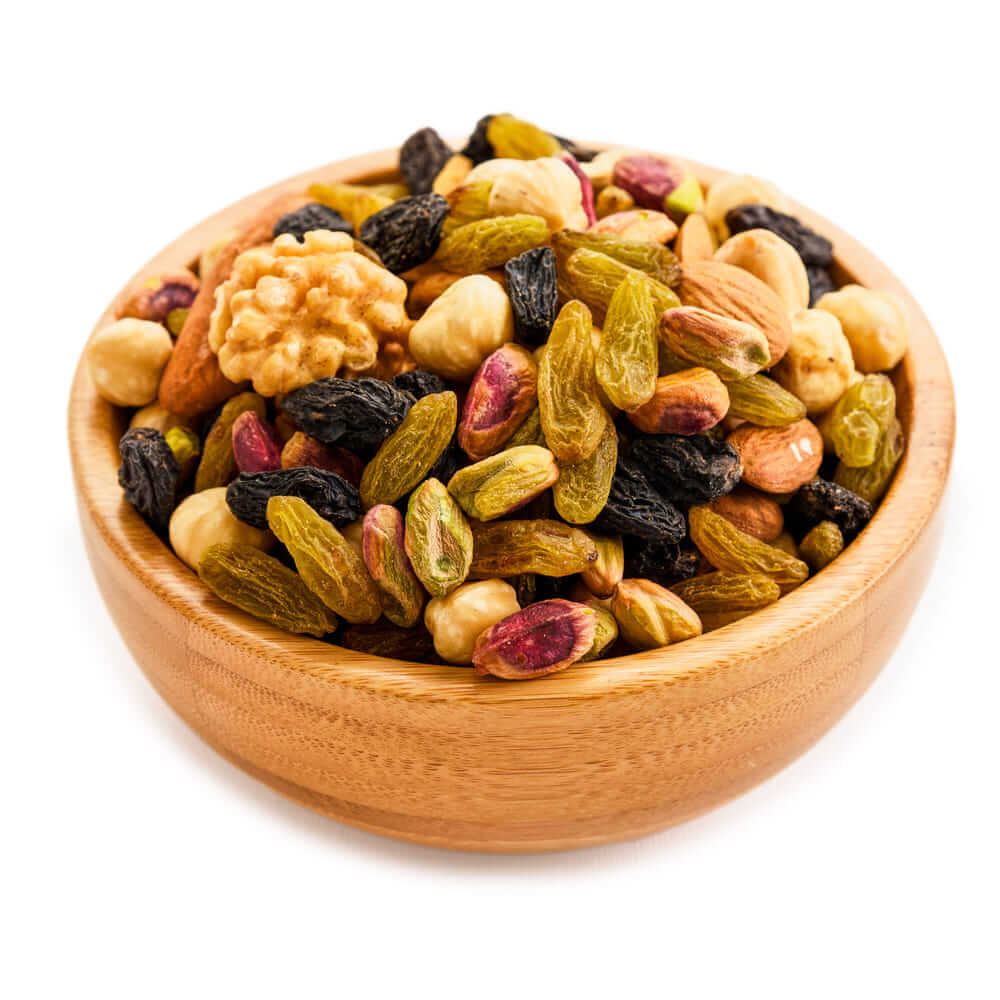
People welcome their guests during Nowruz holiday with the lovely and nutritious Ajil. If you want to have a complete Persian new year menu, you should not miss it. Ajil is a mixture of raw nuts like pistachios, almonds, walnuts, and hazelnuts along with dried fruits such as apricots and raisins.
Nowruz pastries
If you take a quick look at Persian new year recipes, it is pretty impossible for you not to find any pastries. Iranians have sweet teeth and prepare a variety of Persian new year cookies and pastries with heavenly flavors and odors. Here are 4 lovely ones.
Baklava
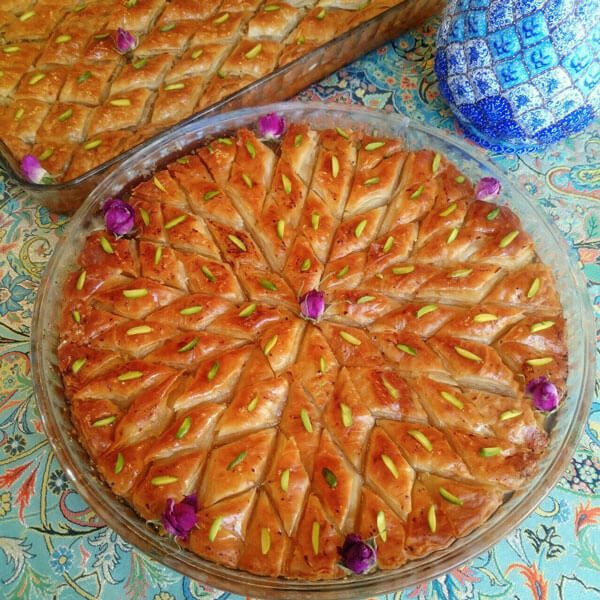
Baklava is a common and popular pastry in many middle eastern cultures, and one of its different types is Persian baklava. This fantastic Nowruz food or better to say dessert, is made with phyllo pastry and chopped nuts bound together with honey or sugar syrup. The loveliest guests are welcomed with baklava in Iran!
Sohan Asali
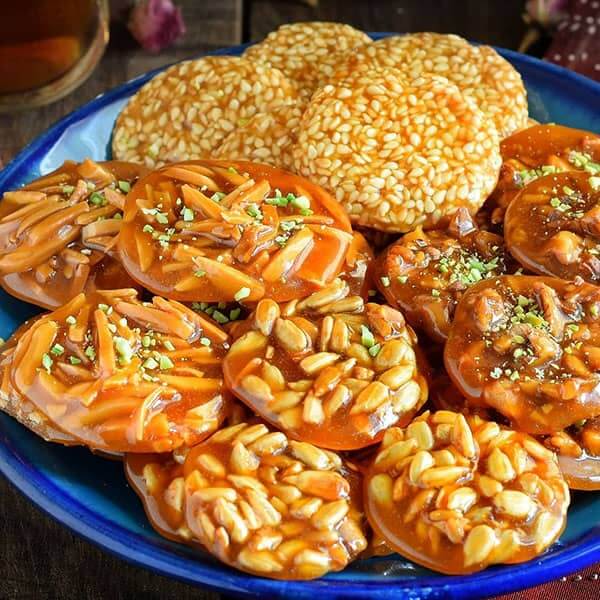
Another pastry that usually shows up at Nowruz table is Sohan asali. It is loved by many people especially children, and you can easily cook it at home. Sahan asali is made with caramelized sugar mixed with different nuts and also saffron.
Nan Berenji
Nan Berenji is a popular Nowruz food, made with rice flour, eggs, and sugar. These small cookies can get a wonderful flavor and, they smell perfectly with the addition of rose water and poppy seeds.
Qottab
Qottab or Ghotab is souvenir of Yazd and Kerman province. It is made of flour, yogurt, egg folk, butter, baking powder, and walnut. This walnut filled crescent is flavorful because of its rosewater, cinnamon, and cardamom.
Sizdah bedar foods
People celebrate the last and 13th day of the new year’s holiday outdoor. This day is called sizdah bedar, and people spend it in nature or the countryside as a day-long picnic. They usually get together with their family members, friends, and relatives and enjoy the last day of the holiday playing group games and also eating 2 extra Nowruz foods, dedicated to sizdah bedar! They have to go back to work from the next day, and they take advantage of their holiday in the best way.
Ash-e-Reshteh
Ash-e-reshte is a hearty and delicious Persian noodle soup that can be served either as an appetizer, main course or at the evening gatherings. Beside noodles, it includes chickpeas, lentils, onions, and herbs. Ash-e-Reshteh can be a fantastic food for Nowruz to be ended.
Kahu with Sekanjebin
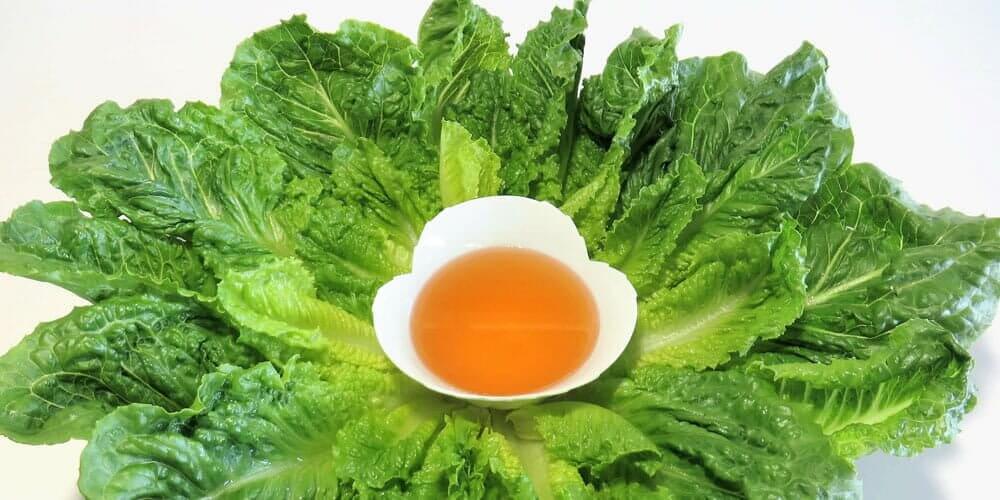
Kahu is lettuce in Persian language, and Sekanjebin is a kind of traditional Persian syrup made from sugar, rose water, mint, and vinegar. Iranians put lettuce leaves into Sekanjebin syrup and then serve it. It tastes wonderful and can be a great snack for Sizdah Bedar on Nowruz table.
Nowruz ceremony in Afghanistan
Afghan people do not have Haft sin, and their ceremony is different. They prepare Samanu and Haft Mewa. Haft Mewa means seven fruits, and it contains two types of raisins, pistachio, almond, walnut, senjed, and dry apricot. It is sweet, and they use rosewater or sometimes vanilla to make it flavoured.
At the end
Persian new year table items vary a lot, and people in different cities may have their own traditional food for Nowruz. So it was somehow impossible to introduce all of the Nowruz foods in this blog. If you have any other Nowruz food ideas, please share them with us in the comments below. It would be so exciting for me to read about Nowruz table from your point of view.

